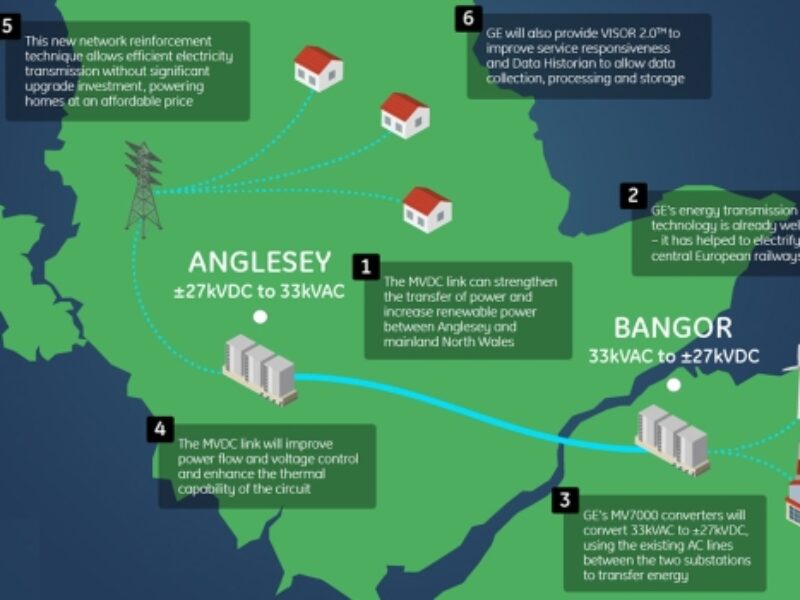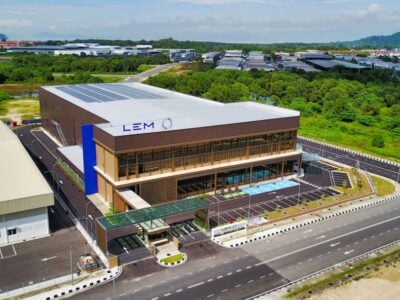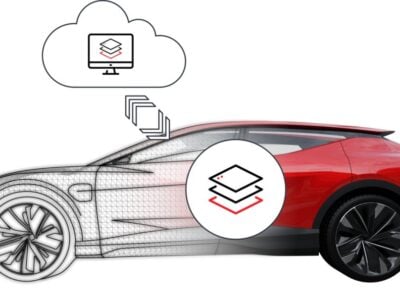
EU’s first medium-voltage DC power link supports renewables
Using DC distribution links have been growing in popularity around the world, providing more control of the power flow, reactive power and voltage support, as well as minimizing network losses. This is increasingly important with more variable renewable energy sources such as wind and tidal power.
The four year Angle-DC project is supporting the transfer of renewable power between Anglesey and Mainland North Wales by converting the existing 33kV AC link to 27kV DC. This conversion will also help with the thermal management of the network, avoiding cables and equipment overheating at peak power levels. The link currently carries up to 80MW and that is set to double by 2020, but some of the cables are several kilometres long and 40 years old.
“As electricity demand and the connection of renewable generation continues to grow, the existing network infrastructure struggles to cope and additional reinforcement becomes necessary,” said Kevin Smith, Future Networks Lead Engineer at lead operator Scottish Power Energy Networks. “The Angle-DC project, being the first of its kind, will hopefully demonstrate that using MVDC on existing assets can be a more innovative alternative to simply building more substations along with the connecting underground cables and overhead lines.”
GE’s Power Conversion AC-DC converters will be located at a 33kV substation in Bangor (above) and at a similar substation on the Isle of Anglesey. The 12 MV7000 converters at each substation will convert 33 kVac to ±27kVdc using the existing AC lines between the two substations.
GE will also be including VISOR 2.0, an asset management tool that provides remote connectivity to improve service responsiveness, and Data Historian, a data management software that allows data collection, processing and storage, as part of the installation. This ability to capture and analyze data will allow SP Energy Networks to review the capabilities of the MVDC system and gather insights to develop optimum control algorithms for the distribution system.
“GE has extensive experience in energy transmission technology and proven track records including electrifying the central European railways,” said Matt Cunningham, sales director for GE Power Conversion. “We are excited to be involved, applying our technology know-how based on our previous experience, at a time when many countries are considering how to future proof their existing infrastructure without significant upheaval,”
Sascha Heinecke, industry segment leader, GE’s Power Conversion, added: “The project is first of its kinds in the UK and Europe. This is a significant step forward in the power transmission and distribution segment. With the deployment of digital tools such as Visor and Historian, the success of this project could impact how grids across the world are future-proofed.”
Next: Other projects
Another UK power distribution company, Western Power Distribution, is trialling a 20 MVA medium voltage (33kV) back-to-back power electronic convertor (AC-DC-AC) to overcome voltage and thermal issues at one of their primary substations. The converter is capable of importing and exporting 5 MVAr of reactive power, which will enable a network voltage change of 2.5% and unlocking additional capacity.
It will transfer power between two 33kV networks that cannot currently be connected due to circulating current issues. This scheme is different to Angle-DC in that it does not feature a significant length of DC cable which creates a number of additional challenges.
An MVDC converter has also been deployed at the Paimpol Bréhat Tidal Demonstration Farm in France. This converts the 690V AC output from two 2MW tidal stream turbines to 10kV DC. The power is transferred through a 16km DC link, then converted to 6.6kV AC and stepped up to a mains voltage of 20kV AC on the mainland.
The converter is used to accept two variable frequency power inputs and convert them to one constant frequency AC output and enables the tidal stream generators to connect to the AC network. One side of the DC converter is completely submerged in a single AC container and will be raised every five years for maintenance.
Related articles
WORLD RECORD 1100KV DC POWER NETWORK ROLLS OUT IN CHINA
NOW, THAT’S A RESISTOR….SURGE LIMITER HANDLES 48 MJ
 If you enjoyed this article, you will like the following ones: don't miss them by subscribing to :
eeNews on Google News
If you enjoyed this article, you will like the following ones: don't miss them by subscribing to :
eeNews on Google News




